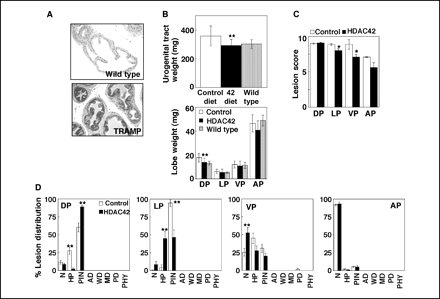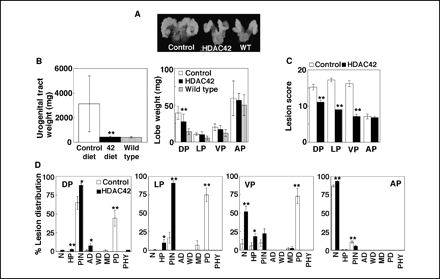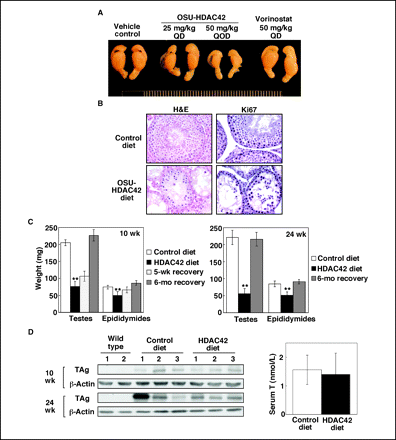
| Size | Price | Stock | Qty |
|---|---|---|---|
| 5mg |
|
||
| 10mg |
|
||
| 25mg |
|
||
| 50mg |
|
||
| 100mg |
|
||
| 250mg |
|
||
| Other Sizes |
|
Purity: ≥98%
AR-42 (HDAC-42, NSC-736012, OSU-42 etc.) is a novel and potent histone deacetylase (HDAC) inhibitor with potential antitumor activity. At 30 nM, its IC50 inhibits HDAC. It exhibits strong in vivo antitumor efficacy against a variety of tumor types, including hepatic and prostate cancers, as well as strong anti-proliferative activity against different cancer cell lines.
| Targets |
HDAC ( IC50 = 16 nM )
|
||
|---|---|---|---|
| ln Vitro |
|
||
| ln Vivo |
|
||
| Enzyme Assay |
Using an HDAC assay kit, HDAC activity is measured. This assay is based on the observation that the biotinylated [3H]-acetyl histone H4 peptide bound to streptavidin agarose beads can be deacetylated through the action of DU-145 nuclear extract, which is high in HDAC activity. The HDAC activity is determined by measuring the amount of [3H]-acetate released into the supernatant. A positive control is employed, namely sodium butyrate (0.25-1 mM).
|
||
| Cell Assay |
For ninety-six hours, cells are exposed to varying concentrations of AR-42. After removing the medium, 150 μL of 0.5 mg/mL MTT in RPMI 1640 medium is added, and the cells are incubated for two hours at 37 °C in a CO2 incubator. After removing the supernatants from the wells, 200 μL of DMSO per well is used to solubilize the reduced MTT dye. At 570 nm, absorbance is measured on a plate reader.
|
||
| Animal Protocol |
|
||
| References |
[1]. J Med Chem . 2005 Aug 25;48(17):5530-5. [2]. J Biol Chem . 2005 Nov 18;280(46):38879-87. [3]. Clin Cancer Res . 2006 Sep 1;12(17):5199-206. [4].Cancer Res . 2007 Jun 1;67(11):5318-27. [5]. Cancer Res . 2008 May 15;68(10):3999-4009. [6]. Blood . 2010 May 27;115(21):4217-25. |
||
| Additional Infomation |
(S)-HDAC-42 is an amidobenzoic acid.
AR-42 has been used in trials studying the treatment of Meningioma, Acoustic Neuroma, Testicular Lymphoma, Intraocular Lymphoma, and Vestibular Schwannoma, among others. HDAC Inhibitor REC-2282 is an orally available phenylbutyrate-derived histone deacetylase (HDAC) inhibitor, with potential antineoplastic activity. Upon oral administration, REC-2282 inhibits the catalytic activity of HDAC, which results in an accumulation of highly acetylated chromatin histones, the induction of chromatin remodeling and an altered pattern of gene expression. This leads to the inhibition of tumor oncogene transcription, and the selective transcription of tumor suppressor genes, which inhibits tumor cell division and induces tumor cell apoptosis. HDAC, an enzyme upregulated in many tumor types, deacetylates chromatin histone proteins. |
| Molecular Formula |
C18H20N2O3
|
|
|---|---|---|
| Molecular Weight |
312.36
|
|
| Exact Mass |
312.147
|
|
| Elemental Analysis |
C, 69.21; H, 6.45; N, 8.97; O, 15.37
|
|
| CAS # |
935881-37-1
|
|
| Related CAS # |
|
|
| PubChem CID |
6918848
|
|
| Appearance |
White to light brown solid powder
|
|
| Density |
1.223
|
|
| LogP |
3.647
|
|
| Hydrogen Bond Donor Count |
3
|
|
| Hydrogen Bond Acceptor Count |
3
|
|
| Rotatable Bond Count |
5
|
|
| Heavy Atom Count |
23
|
|
| Complexity |
397
|
|
| Defined Atom Stereocenter Count |
1
|
|
| SMILES |
[C@@H](C1C=CC=CC=1)(C(C)C)C(=O)NC1C=CC(C(=O)NO)=CC=1
|
|
| InChi Key |
LAMIXXKAWNLXOC-INIZCTEOSA-N
|
|
| InChi Code |
InChI=1S/C18H20N2O3/c1-12(2)16(13-6-4-3-5-7-13)18(22)19-15-10-8-14(9-11-15)17(21)20-23/h3-12,16,23H,1-2H3,(H,19,22)(H,20,21)/t16-/m0/s1
|
|
| Chemical Name |
N-hydroxy-4-[[(2S)-3-methyl-2-phenylbutanoyl]amino]benzamide
|
|
| Synonyms |
|
|
| HS Tariff Code |
2934.99.9001
|
|
| Storage |
Powder -20°C 3 years 4°C 2 years In solvent -80°C 6 months -20°C 1 month |
|
| Shipping Condition |
Room temperature (This product is stable at ambient temperature for a few days during ordinary shipping and time spent in Customs)
|
| Solubility (In Vitro) |
|
|||
|---|---|---|---|---|
| Solubility (In Vivo) |
Solubility in Formulation 1: ≥ 5 mg/mL (16.01 mM) (saturation unknown) in 10% EtOH + 40% PEG300 + 5% Tween80 + 45% Saline (add these co-solvents sequentially from left to right, and one by one), clear solution.
For example, if 1 mL of working solution is to be prepared, you can add 100 μL of 50.0 mg/mL clear EtOH stock solution to 400 μL PEG300 and mix evenly; then add 50 μL Tween-80 to the above solution and mix evenly; then add 450 μL normal saline to adjust the volume to 1 mL. Preparation of saline: Dissolve 0.9 g of sodium chloride in 100 mL ddH₂ O to obtain a clear solution. Solubility in Formulation 2: ≥ 5 mg/mL (16.01 mM) (saturation unknown) in 10% EtOH + 90% (20% SBE-β-CD in Saline) (add these co-solvents sequentially from left to right, and one by one), clear solution. For example, if 1 mL of working solution is to be prepared, you can add 100 μL of 50.0 mg/mL clear EtOH stock solution to 900 μL of 20% SBE-β-CD physiological saline solution and mix evenly. Preparation of 20% SBE-β-CD in Saline (4°C,1 week): Dissolve 2 g SBE-β-CD in 10 mL saline to obtain a clear solution. View More
Solubility in Formulation 3: ≥ 5 mg/mL (16.01 mM) (saturation unknown) in 10% EtOH + 90% Corn Oil (add these co-solvents sequentially from left to right, and one by one), clear solution. Solubility in Formulation 4: ≥ 1 mg/mL (3.20 mM) (saturation unknown) in 10% DMSO + 40% PEG300 + 5% Tween80 + 45% Saline (add these co-solvents sequentially from left to right, and one by one), clear solution. For example, if 1 mL of working solution is to be prepared, you can add 100 μL of 10.0 mg/mL clear DMSO stock solution to 400 μL of PEG300 and mix evenly; then add 50 μL of Tween-80 to the above solution and mix evenly; then add 450 μL of normal saline to adjust the volume to 1 mL. Preparation of saline: Dissolve 0.9 g of sodium chloride in 100 mL ddH₂ O to obtain a clear solution. Solubility in Formulation 5: ≥ 1 mg/mL (3.20 mM) (saturation unknown) in 10% DMSO + 90% (20% SBE-β-CD in Saline) (add these co-solvents sequentially from left to right, and one by one), clear solution. For example, if 1 mL of working solution is to be prepared, you can add 100 μL of 10.0 mg/mL clear DMSO stock solution to 900 μL of 20% SBE-β-CD physiological saline solution and mix evenly. Preparation of 20% SBE-β-CD in Saline (4°C,1 week): Dissolve 2 g SBE-β-CD in 10 mL saline to obtain a clear solution. Solubility in Formulation 6: ≥ 1 mg/mL (3.20 mM) (saturation unknown) in 10% DMSO + 90% Corn Oil (add these co-solvents sequentially from left to right, and one by one), clear solution. For example, if 1 mL of working solution is to be prepared, you can add 100 μL of 10.0 mg/mL clear DMSO stock solution to 900 μL of corn oil and mix evenly. Solubility in Formulation 7: 0.5% methylcellulose+0.2% Tween 80: 30mg/mL |
| Preparing Stock Solutions | 1 mg | 5 mg | 10 mg | |
| 1 mM | 3.2014 mL | 16.0072 mL | 32.0143 mL | |
| 5 mM | 0.6403 mL | 3.2014 mL | 6.4029 mL | |
| 10 mM | 0.3201 mL | 1.6007 mL | 3.2014 mL |
*Note: Please select an appropriate solvent for the preparation of stock solution based on your experiment needs. For most products, DMSO can be used for preparing stock solutions (e.g. 5 mM, 10 mM, or 20 mM concentration); some products with high aqueous solubility may be dissolved in water directly. Solubility information is available at the above Solubility Data section. Once the stock solution is prepared, aliquot it to routine usage volumes and store at -20°C or -80°C. Avoid repeated freeze and thaw cycles.
Calculation results
Working concentration: mg/mL;
Method for preparing DMSO stock solution: mg drug pre-dissolved in μL DMSO (stock solution concentration mg/mL). Please contact us first if the concentration exceeds the DMSO solubility of the batch of drug.
Method for preparing in vivo formulation::Take μL DMSO stock solution, next add μL PEG300, mix and clarify, next addμL Tween 80, mix and clarify, next add μL ddH2O,mix and clarify.
(1) Please be sure that the solution is clear before the addition of next solvent. Dissolution methods like vortex, ultrasound or warming and heat may be used to aid dissolving.
(2) Be sure to add the solvent(s) in order.
| NCT Number | Recruitment | interventions | Conditions | Sponsor/Collaborators | Start Date | Phases |
| NCT02569320 | Completed | Drug: Dexamethasone Drug: HDAC Inhibitor AR-42 |
Recurrent Plasma Cell Myeloma | Ohio State University Comprehensive Cancer Center |
May 20, 2016 | Phase 1 |
| NCT01798901 | Completed | Drug: HDAC inhibitor AR-42 Drug: decitabine |
Adult Acute Myeloid Leukemia With Inv(16)(p13;q22) Adult Acute Myeloid Leukemia With t(15;17)(q22;q12) |
Alison Walker | September 17, 2013 | Phase 1 |
| NCT02282917 | Completed | Drug: AR-42 | Vestibular Schwannoma Meningioma |
Massachusetts Eye and Ear Infirmary |
December 2015 | Early Phase 1 |
| NCT02795819 | Terminated | Drug: AR-42 Drug: Pazopanib |
Renal Cell Carcinoma Soft Tissue Sarcoma |
Virginia Commonwealth University |
July 8, 2016 | Phase 1 |
|
|---|
  |
 |